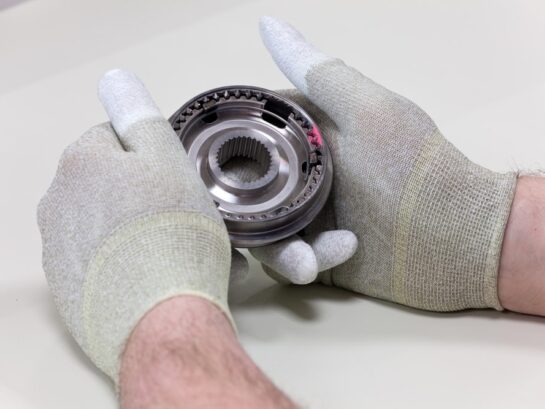What does Visual Inspection/Visibly Clean Mean?
Visual inspection (VI) is the most basic method of quality control which involves inspecting an item simply using the naked eye. Companies and individuals around the world have been using this method for centuries. Today, it comes with a level of quality and standards that must be abided by in order for an item to pass the inspection.
These standards ensure that there are no discrepancies between inspections and each item is inspected equally.
Visibly clean (VC) is the state of an item that has no surface contamination visible when using additional lighting aids, angle of incidence, viewing distance and angle, and normal or magnified vision. A visibly clean item has thus passed this level of quality control.
The Importance of Lighting and Vision
Visual inspections are done by an individual who has 20/20 vision, or vision that has been corrected to this level. This is a crucial standard. Someone with a different level of vision could miss finer details that need to be addressed.
In addition to the level of vision the individual completing the visual inspection has, the distance at which they view is equally important. Each visual inspection involves viewing from a handful of standard viewing distances, with each distance requiring a certain amount of lighting. If a surface is unable to be reached for normal visual inspection, small tools will be utilized. This could include a borescope or other inspection aids.
The level of lighting used to perform a visual inspection is regulated and stringently measured using a calibrated light meter. White light above 500 lumens per square meters is the minimum requirement for many of the levels of inspection criteria. From there, higher amounts of white lighting are used in addition to UV lighting at a very close observation distance to ensure a quality inspection.
UV lighting, otherwise called a black light, is an extremely useful tool in the visual inspection process. This type of lighting falls in the 1,000 to 4,000 Angstroms wavelength range, which is not visible to the human eye. An Angstrom is a metric unit of the visible wavelength of light. For a typical UV inspection, a black light of 3,200 to 3,800 Angstroms is used as a requirement. Specifying a small window of acceptable wavelength ensures that each UV inspection is standardized. The UV light also needs to have a minimum level of intensity at 24 inches away.
UV light is invaluable because it causes many common hydrocarbon or organic oils and greases to fluoresce when they might not be otherwise detectable by other visual means. To fluoresce means to shine or glow brightly. The UV light illuminates further impurities not spotted by a basic inspection.
Why Is Visual Inspection/Visibly Clean Important?
Requiring a visual inspection is important for maintaining a certain level of quality for all items. In addition to detecting larger particular matter and oils/greases, it also can spot smaller particulate items as well as defects within the surface.
Visual inspection is a crucial step in quality control to ensure no defective products are sent out. In receiving pieces to be used for completing a larger project, visual inspection finds potential issues before putting the parts to use. If a part with surface contamination or defects is utilized, it can have catastrophic results. It is important that even small crevices be inspected because even missing a small amount of particles could mean damage and machine inaccuracy. For example, a part that is not visibly clean is now in motion. The small particles that were overlooked are able to now wear away at components and cause the entire machine to malfunction.
Visual Inspection for IAW STP 0637 (Boeing)
Throughout the precision cleaning process, visual inspections are completed many times. For example, when the item is received, after a rough cleaning, after a precision cleaning, prior to packaging, and prior to bubble wrapping. Every element of a part is inspected: using a flashlight, using a black light, peeking down pipes, looking down tubes, looking at each filter element, and sending scopes to reach portions not accessible.
For the IAW STP 0637 (Boeing) inspection, a table of requirements for each level of visibly clean was specified. There were 3 levels of visibly clean, with an observation distance ranging from 5 feet to 6 inches away. The lighting requirement ranged from normal shop lighting to greater than 1000 lumens per square meter plus the use of ultraviolet light. If the item does not pass a level of inspection, it is re-cleaned and reinspected until it is clean of particulates.
Choose a Expert In Visual Inspection/Visibly Clean
Here at Precision Fabricating & Cleaning we withhold an expert level of visual inspection to ensure quality results. We specialize in cleaning and testing services including passivation/passivating, chemical cleaning, solvent cleaning, bubble point testing, oxygen cleaning, cryogenic & cold shock testing, ultrasonic cleaning and pneumatic testing for items such as gauges, components, valves, filters, and many more. Complex hardware requires precision cleaning to numerous stringent specifications in order to operate properly.
Located along the Space Coast of Florida, we have had the pleasure to serve customers such as Boeing, SpaceX, Lockheed Martin, General Electric, NASA, and Mitsubishi. We are a commercial and government small business contractor. Precision Fabricating & Cleaning facilities are ISO 9001 / AS9100 registered and contain over 25 acres and have comprehensive support for welding, machining, abrasive blasting, painting, cleaning, testing, and large-scale assembly operations. Our extensive experience and specialized knowledge allow us to satisfy a wide range of requirements. We’re known for our high level of service and timely delivery. We’ll ensure your crucial maintenance needs are exceeded so that even the most challenging of industrial projects can be fulfilled. Contact PFC today.

